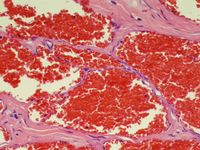Difference between revisions of "Haemangioma"
| Line 38: | Line 38: | ||
[[Category:Expert Review]] | [[Category:Expert Review]] | ||
[[Category:WikiBlood|Z]] | [[Category:WikiBlood|Z]] | ||
| + | [[Category:Cardiology Section]] | ||
Revision as of 15:35, 15 October 2013
Introduction
Haemangiomas are benign tumours of the vascular epithelium and soft tissues. They occur most commonly in dogs, occasionally in cats and horses and rarely in cattle and pigs. In dogs the tumours frequently occur on the distal extremities and the trunk. A widespread, disseminated form of the disease has been reported in dairy cattle affecting the skin and internal organs.
The tumours are classified as cavernous or capillary haemangiomas depending on the size of the vascular spaces.
Signalment
In horses, young animals less than a year of age are most frequently affected. Cats and dogs most frequently develop haemangiomas as adults; the average age of affected dogs is nine years.
Clinical signs
Haemangiomas usually appear as single to multiple circumscribed nodules that are red to black in colour. Those on the skin may be ulcerated and may bleed due to self-trauma, particularly if located on the face. Feline hemangiomas appear as solitary tumors in the dermis and subcutis without any site predilection.
Histological features
Haemangiomas are often well circumscribed and are composed of vascular spaces filled with red blood cells and lined by a layer of well-differentiated endothelial cells. Evidence for acute or chronic haemorrhage within the mass is often noted resulting in erythrophagocytosis or haemosiderin-laden macrophages, and organised thrombi are a frequent finding.
Treatment
Haemangiomas are generally slow growing and the treatment of choice is surgical excision. Local haemangiomas of the skin and mouth may also respond to thermocautery or radiation therapy. Cryosurgery may be required to successfully treat some of the verrucous variants reported in large animals.
Prognosis
Surgical treatment of cutaneous haemangioma generally has a good prognosis following surgical excision and metastasis is rare.
| Haemangioma Learning Resources | |
|---|---|
 Search for recent publications via CAB Abstract (CABI log in required) |
Haemangioma publications |
References
- Meuten, D. J. (2002) Tumours in Domestic Animals Wiley-Blackwell
- Radostits, O. M., Arundel, J. H., Gay, C. C. (2000) Veterinary Medicine: a textbook of the diseases of cattle, sheep, pigs, goats and horses Elsevier Health Sciences
- Raskin, R., Meyer, D. J. (Atlas of Canine and Feline Cytology Elsevier Health Sciences
| This article has been peer reviewed but is awaiting expert review. If you would like to help with this, please see more information about expert reviewing. |
Error in widget FBRecommend: unable to write file /var/www/wikivet.net/extensions/Widgets/compiled_templates/wrt677c3fc2704915_98259302 Error in widget google+: unable to write file /var/www/wikivet.net/extensions/Widgets/compiled_templates/wrt677c3fc276ee89_41085564 Error in widget TwitterTweet: unable to write file /var/www/wikivet.net/extensions/Widgets/compiled_templates/wrt677c3fc27dbb03_25058768
|
| WikiVet® Introduction - Help WikiVet - Report a Problem |
